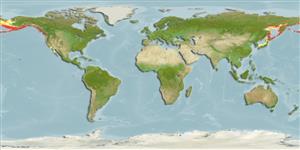>
Salmoniformes (Salmons) >
Salmonidae (Salmonids) > Salmoninae
Etymology: Oncorhynchus: Greek, onyx, -ychos = nail + Greek, rhyngchos = snout (Ref. 45335).
More on author: Walbaum.
Environment: milieu / climate zone / depth range / distribution range
Ecologie
marien; zoet water; brak water benthopelagisch; anadroom (Ref. 51243); diepte 0 - 250 m (Ref. 50550), usually ? - 61 m (Ref. 96339). Temperate; 0°C - 24°C (Ref. 35682); 67°N - 24°N, 130°E - 110°W (Ref. 117423)
North Pacific: Korea , Japan, Okhotsk and Bering Sea (Ref. 1998), Arctic Alaska south to San Diego, California, USA. Asia: Iran (Ref. 39702).
Lengte bij maturiteit / Grootte / Gewicht / Leeftijd
Maturity: Lm 70.0 range ? - ? cm
Max length : 100.0 cm FL mannelijk / geslacht onbekend; (Ref. 559); common length : 58.0 cm TL mannelijk / geslacht onbekend; (Ref. 3561); max. gepubliceerd gewicht: 15.9 kg (Ref. 40637); max. gerapporteerde leeftijd: 7 Jaren (Ref. 1998)
Dorsale stekels (totaal) : 0; Dorsale zachte stralen (totaal) : 10 - 14; Anale stekels: 0; Anale zachte stralen: 13 - 17; Wervels: 59 - 71. Distinguished by the lack of distinct black spots on the back and tail and by the presence of 18 to 28 short, stout, smooth gill rakers on the first arch (Ref. 27547). Pelvic fins with axillary process; caudal truncate to slightly emarginate (Ref. 27547). Large individuals are steel-blue dorsally, with speckles of black; silver on the sides; silvery to white ventrally. Males have tinges of black on the tips of its caudal, anal and pectoral fins. Spawning males are dark olive to black dorsally; grey-red with green vertical bars on the sides; dark grey ventrally; anal and pelvic fins with white tips. Spawning females resemble spawning males but less distinctly marked.
Inhabits ocean and coastal streams (Ref. 86798). Migrating fry form schools in estuaries, remain close to shore for a few months and finally disperse to enter the sea (Ref. 1998). Epipelagic (Ref. 58426). Juveniles and adults feed mainly on copepods, tunicates and euphausiids but also on pteropods, squid and small fishes (Ref. 1998). Adults cease feeding in freshwater (Ref. 1998). Males and females die after spawning. The catch is mostly canned but also sold fresh, dried-salted, smoked, and frozen. Eaten steamed, fried, broiled, boiled, microwaved, and baked (Ref. 9988). Utilized for caviar.
Enters freshwater during advanced stage of sexual development and spawning occurs almost immediately (Ref. 1998). Spawning occurs at depths of ~3 meters, current speeds of ~20cm/sec. near the head waters over sand and pebbles at 4-11° C water temperature. At spawning time the female excavates a hole of around 1 meter diameter and 50 cm depth before spawning can occur (Ref. 12218). Nest building is done by the female by lying on one side and lashing its tail to displace the sand and silt on the river bed. The pair then settles in the nest, mouths gape, and with rapid vibration of the pair, eggs and milt are released. The female then covers the nest. Males are aggressive and may spawn with different females; females likewise may spawn with other males and therefore builds different nests. Adults die after a week (Ref. 1998). A fish spawns 700-7,000 eggs in two to three egg releases. Eggs are ~300-3,500 per spawn. Egg size is ~6.7 mm, water temp. is 8-10°C at 60 days before hatching. Larva size is around 16 mm. Come springtime the juveniles go to the ocean and come back 3-4 years later to their exact birthplace. This fish reaches maturity in 2-4 years. Larvae are found around the spawning site, Juveniles are found around the coast. Juveniles migrate to the ocean at ~27-45 mm during February at water temperatures around 4° C (Ref. 12218).
Reproductive strategy: synchronous ovarian organization, determinate fecundity (Ref. 51846).
Page, L.M. and B.M. Burr, 2011. A field guide to freshwater fishes of North America north of Mexico. Boston : Houghton Mifflin Harcourt, 663p. (Ref. 86798)
Status op de Rode Lijst van het IUCN (Ref. 130435: Version 2024-1)
Gevaar voor de mens
Harmless
Gebruik door de mens
Visserij: van groot commercieel belang; Aquacultuur: commercieel; sportvis: ja; Aquarium: Publieke aquaria
Tools
Speciale rapporten
Download XML
Internetbronnen
Estimates based on models
Preferred temperature (Ref.
123201): 1.1 - 8.3, mean 3.3 °C (based on 192 cells).
Fylogenetische diversiteitsindex (Ref.
82804): PD
50 = 0.5000 [Uniqueness, from 0.5 = low to 2.0 = high].
Bayesian length-weight: a=0.01445 (0.00751 - 0.02781), b=3.10 (2.94 - 3.26), in cm total length, based on LWR estimates for this species & Genus-body shape (Ref.
93245).
Trofisch niveau (Ref.
69278): 3.7 ±0.2 se; based on diet studies.
Weerstandsvermogen (Ref.
120179): Gemiddeld, minimale populatieverdubbelingstijd 1,4-4,4 jaar (K=0.27-0.45; tm=2-5; tmax=6).
Prior r = 0.32, 95% CL = 0.21 - 0.48, Based on 8 full stock assessments.
Fishing Vulnerability (Ref.
59153): Moderate to high vulnerability (49 of 100).
Climate Vulnerability (Ref.
125649): High to very high vulnerability (71 of 100).
Nutrients (Ref.
124155): Calcium = 15.6 [4.4, 41.3] mg/100g; Iron = 0.337 [0.168, 0.758] mg/100g; Protein = 18.4 [17.2, 19.5] %; Omega3 = 1.71 [0.78, 3.77] g/100g; Selenium = 110 [32, 369] μg/100g; VitaminA = 13.3 [4.6, 41.2] μg/100g; Zinc = 0.424 [0.266, 0.821] mg/100g (wet weight);
